Ijraset Journal For Research in Applied Science and Engineering Technology
- Home / Ijraset
- On This Page
- Abstract
- Introduction
- Conclusion
- References
- Copyright
Effect of Hard Chroming on Wear Loss of Rotavator Blade
Authors: Shivani S. Bawane, Dr. A. M. Nikalje
DOI Link: https://doi.org/10.22214/ijraset.2022.47053
Certificate: View Certificate
Abstract
: Rotavator is the most important equipment which has been increasingly used in agricultural fields. To decrease the human effort and total time required in soil bed preparation. During the working condition, the rotary tiller is subjected to extreme abrasive wear. This problem is faced all over the world. Which considerably affects the service life of the tiller blade. Due to the abrasive wear, the rotavator blade requires frequent replacement resulting in increasing machine downtime and maintenance costs. So, it is necessary to improve the service life of the tiller blade. In the present research work laboratory test was conducted on rotavator blade specimen. Hard chroming is used as a surface modification technique, experimentation was conducted to evaluate the effect of chromium coating on the mechanical properties of the base material. The addition of chromium increases the surface hardness of the tiller blade. Tribometer is used for the wear testing method, to study the wear resistance of the coated and uncoated blade. Taguchi L9 array to optimize the laboratory investigation used in the present research work. Wear performance of hard chroming and the unhardchrome blade is examined after a fixed interval of time in terms of weight loss.
Introduction
I. INTRODUCTION
The rotary tiller is equipment that is used by the farmer for the preparation of seedbeds in the agricultural field, under the various load this blade is subjected to extreme abrasive wear and fatigue [1]. Abrasive wear is the type of wear that results in the disintegration of the workpiece material on the surface due to the influence of the hard particle in contact with the surface. It also occurs when a hard rough surface or particle interacts with the soft surface and cause material loss, this type of abrasive wear develops in many agricultural tools especially engaged in some dry land agricultural area. It may cause the failure of the tool and need to change from time to time. The farmer always faced the problem of the replacement cost of worn-out earth-engaging components. This problem also occurs in the rotavator blade which results in lowering the life of the tiller blade, due to this the cost of soil bed preparation will be increased.
There are several techniques are present to improve the surface properties of base material, like coating, polishing, heat treatment, hard facing, etc [3].
Which has been used to increase the wear resistance of tools. In this research work, hard chroming is suggested for improving the service life of the tiller blade. Hard chroming is a type of electroplating process in which a chromium layer will be deposited on the base material, The aim of this study was to ascertain the wear behaviors of rotavator blade hard chrome with three different thicknesses compared with standard rotavator blade.
Taguchi technique is used as an optimization technique to improve the methodology of investigation for optimal result data. Taguchi is the best optimization technique that gives a significant conclusion with a minimum number of experimental runs and reduced the cost of testing. It is a simple, efficient, and systematic optimization technique designed for high-quality data. Taguchi method is a process/ product optimization technique that is based on 7 steps, selection of factors, determining the number of levels, choosing correct OA, assignment of variables and interaction to column, experimentation, result in analysis, and confirmation test. As per this method, an experiment that we perform consist of several input factor some are controllable and some are uncontrollable. In this study, the wear behaviour of coated and uncoated blades of rotavators has been analyzed in a laboratory. The laboratory testing was carried out at three different loads 15, 20,25N, thickness 60,70,80 µm, and temperatures 45,50,55°C. L9 array with lower is better was used to optimize testing parameters.
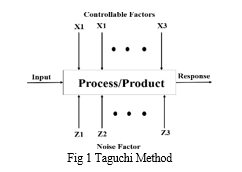
II. EXPERIMENTAL DETAIL
A. Workpiece material and method implementation
In this experimentation, mild steel rotavator blades are used for the laboratory test. The chemical composition of the regular blade is shown in table 1. Hard chroming is a surface modification process to improve the mechanical properties of the base material. The rotavator blade has been covered with Three different thicknesses of chromium to increase their hardness. The main reason for this hard chroming method being chosen is that they provide high resistance to wear and the second one is that they are comparatively economical in the market. The specimen used for testing is shown in fig 2.
Table 1. chemical composition (wt.%) of mild steel.
|
Element |
% Element |
|
Carbon |
0.25-0.290 % |
|
Copper |
0.20 % |
|
Iron |
98.0 % |
|
Manganese |
1.03 % |
|
Phosphorus |
0.040 % |
|
Silicon |
0.280 % |
|
Sulfur |
0.050 % |
|
Carbon |
0.25 - 0.290 % |
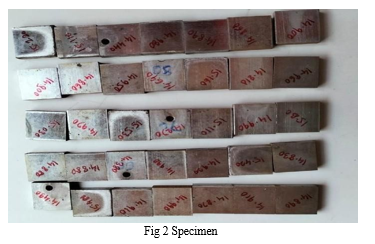
B. Laboratory test
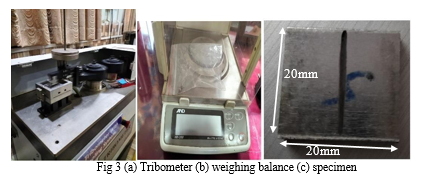
A rectangular specimen of 20X20X5mm was prepared for a wear test to be performed on the tribometer as per ASMT G99-95 standard. The specimen was hard chrome at their cross-section on one side and subsequent machine to specified size as shown in fig 3(c). The tribometer test apparatus (TR-201 Ducom, India) used in this studyis shown in fig 3(a). The wear test was performed under dry sliding conditions. Before and after the test, all the specimens taken for analysis were cleaned and ten weighted using an electronic balance as shown in fig 3(b). During the wear test, the load 15, 20,25N, temperature 45,50.55°C, and thickness 60,70,80 µm these three input parameters are considered.
III. RESULTS AND DISCUSSION
To get a complete understanding of the effect of input parameter thickness, load, and temperature on output wear rate. You usually access the signal to noise (S/N) ratio or main effect plot for means. For this purpose, Minitab 22 statistical software has been used. Wear rates have been done. ANOVA has been conducted to find out the effect of each parameter on wear rate and a linear regression model has been established to predict the value of wear rate.
A. Experimental Result
A tribometer as per ASTM G-99 is performed to investigate the wear resistance of modified and regular rotary tiller blades. Taguchi optimization technique is used to optimize parameters of abrasive wear of blade in the laboratory test. A laboratory test was carried out by varying loads from 15 to 25 N and thickness 60 to 80 µm at temperatures 45 to 55°C. And to minimize the number of experimental runs L9 array is used to investigate the effect of three input parameters for three levels. L9 orthogonal array was used to study the performance of the tiller blade as tabulated in table 2. The wear rate is also tabulated in table 2, which also shows the S/N ratio for all nine experiments.
Table 2. L9 Orthogonal array with Wear rate response characteristic.
|
Experiment |
Input Parameters |
Output Parameters |
|||
|
Run No |
Thickness (µm) |
Load (N) |
Temperature (°C) |
Wear rate |
S/N ratio |
|
1 |
60 |
15 |
45 |
0.0422 |
27.4938 |
|
2 |
60 |
20 |
50 |
0.0533 |
25.4655 |
|
3 |
60 |
25 |
55 |
0.0605 |
24.3649 |
|
4 |
70 |
15 |
50 |
0.0392 |
28.1343 |
|
5 |
70 |
20 |
55 |
0.0414 |
27.6600 |
|
6 |
70 |
25 |
45 |
0.0459 |
26.7637 |
|
7 |
80 |
15 |
55 |
0.0361 |
28.8499 |
|
8 |
80 |
20 |
45 |
0.0313 |
30.0891 |
|
9 |
80 |
25 |
50 |
0.0394 |
28.0901 |
B. Main Effect of Wear Rate
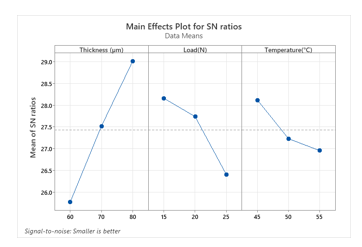
C. Analysis of variance (ANOVA) Result
The analysis of variance is performed in MINITAB 22 software. Table 3 shows the ANOVA, it is a collection of statical models and their associated procedures. The advantage of performing ANOVA is to validate the result obtained from Taguchi. As ANOVA gives the percentage of contribution of each selected controlled parameter and suggested the most significant factor.
ANOVA table shows the result of the analysis. The analysis of variance was performed at 95% confidence level F- value, and P-value R-squared were used to determine the significance of each model parameter. A p-value less than 0.05 (<0.05) indicated the significance as a controlled parameter on wear rate. The p-value for thickness load and the temperature was less than 0.05, representing highly influencing parameters. It is clear from the ANOVA table that thickness is the most dominating parameter on wear rate. The percentage of contribution of thickness is highest i.e., 63.46% and the contribution of load and temperature 20.94% and 9.13% respectively.
Table 3 ANOVA table for Wear rate
|
Source |
DF |
Adj SS |
Adj MS |
F-value |
p-value |
% Contribution |
|
Regression |
3 |
0.000595 |
0.000198 |
24.36 |
0.002 |
|
|
Thickness |
1 |
0.000403 |
0.000403 |
49.59 |
0.001 |
63.46 |
|
Load |
1 |
0.000133 |
0.000133 |
16.41 |
0.010 |
20.94 |
|
Temperature |
1 |
0.000058 |
0.000058 |
7.09 |
0.045 |
9.13 |
|
Error |
5 |
0.000041 |
0.000008 |
|
|
|
|
Total |
8 |
0.000635 |
|
|
|
|
D. Development of Regression Model for Wear Rate
The regression model has been developed using Minitab 22 software. Substituting the experimental values of the input parameter in theregression equation. Value for wear rate has been predicted for all levels of studyparameters. The predicted and experimental value of wear rate correlated with each other is also shown in graphical representation.
Regression Equation
Wear rate = 0.0508 - 0.000820 Thickness (µm) + 0.000943 Load(N) + 0.000620 Temperature(°C)
Table 4 shows a comparison between experimental and predicted wear rates by developing a mathematical equation.
Table 4 Experimental and predicted value of wear rate
|
Sr No |
Experimental value |
Predicted value |
Error% |
|
1 |
0.0422 |
0.0436 |
3.21 |
|
2 |
0.0533 |
0.0514 |
3.56 |
|
3 |
0.0605 |
0.0592 |
2.14 |
|
4 |
0.0392 |
0.0385 |
1.78 |
|
5 |
0.0414 |
0.0453 |
8.60 |
|
6 |
0.0459 |
0.0448 |
1.75 |
|
7 |
0.0361 |
0.0334 |
7.47 |
|
8 |
0.0313 |
0.0319 |
1.88 |
|
9 |
0.0394 |
0.0397 |
0.75 |
IV. CONFIRMATION EXPERIMENT
To confirm the above result and to determine the accuracy of the model developed, a confirmation test is conducted using the same experimental setup. The confirmation experiment is conducted by keeping parameters at the optimum level suggested by Taguchi that the confirmation test shows that the wear rate obtained after experimentation is 0.0301 and the predicted value is 0.0280. it can be seen that the difference between the experimental result and the predicted result is 6.97%. it indicates that % the error is within the acceptable range. Hence the confirmation test validates the result.
Table 5 shows the difference between the experimental value and the predicted from regression mode.
Table 5 Confirmation test for wear rate.
|
Parameters |
Predicted value |
Experimental value |
Error |
|
Wear Rate |
0.0280 |
0.0301 |
6.97% |
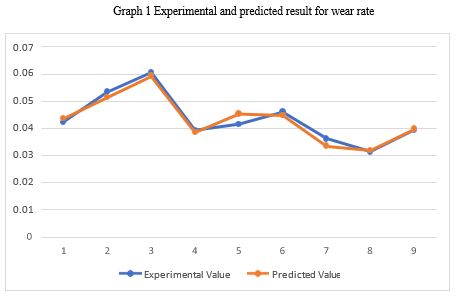
Conclusion
In this study, the influence of operating parameters such as thickness, load, and temperature and their optimization, the following conclusions are drawn from the study. 1) From experimentation the optimal value was found to be 80 thickness, 15N load, and 45°C temperatures but the most important result was that 80 thickness shows better wear resistance. 2) ANOVA results indicate that the contribution of temperature was 63.46%, load 20.94%, and temperature 9.13%. 3) Thickness is the most influencing parameter for abrasive wear 4) Hard chroming is effective to increase wear resistance with the chromium coating was effective in reducing the wear of rotavator blades. 5) The laboratory test revealed that the thickness of chromium coating increased. The wear resistance of the corresponding alloy increases.
References
[1] Amardeep. S. Kang, Gurmeet. S. Cheema, Wear Behavior of Hard facing on rotary tiller blade, Procedia Engineering 97(2014)1442-1451. [2] Ch. Ramulu, A. K. Dave, I. Srinivas and Ashish. S. Dhimate, Effect of Electro-spark Coating on wear Loss of Rotavator Blades, 55(03) (2018) 13-20. [3] Sukhraj. Sigh, Jonny. Garg, P. Singh, Gurprit. Singh, Kaushal. Kumar, Effect Of hard-faced Cr-alloy on abrasive wear of low carbon rotavator blades using design of experiment, Material Today: Proceedings 5(2018) 3390-3395. [4] G.Taguchi, Introduction to Quality Engineering, Tokyo, Asian Productivity Organization,1990. [5] A. yazici, Turkish journal of agricultural and forestry,35(2011)46. [6] A. Singh Kang, G. Singh, G. Singh Cheema, improving wear resistance via hard facing of cultivator shovel, Material Today: Proceedings 4 (2017)7991-7999. [7] Ch. Ramulu, M Arjun Naik, Ak. Dave, I. Srinivas, Cost Economics of Electro Spark coated Rotavator Blades, The Pharma Innovation Journal.10 (7) (2021) 261- 264. [8] A.Yazici, Review of Wear on Tillage Tools: Constraints in Transferring of The Research Findings to the Agricultural sector and Solution Proposals, 17(2) (2021)74- 85. [9] P. Niranatlumpong N, C. Sukhonket, J. Nakngoenthong, Wear Resistant Surface Treatment of Pulverized Blades, Wear 302 (2013) 878-818. [10] A. Natsis, G. Petropooulos, C. Pandazarasas, Tribology International.41(2008) 151-157. [11] S. Kaboonroonyana, V. M. Salokhe, Wear Resistance of Thermally Sprayed Rotary Tiller Blades, Wear,263 (1-6) (2007), 604-608. [12] L. Maria, R. Sathishkumar, J. B. Kumaragurubaran, P. Gopal, Analysis of Hard Chroming Coating Defect and its Prevention Method, International Journal of Engineering and Advanced technology. 2(5) (2013) 2249-8958. [13] N. Zhang, C. Huang, C. Zhang, Anticorrosion property study on the hard chrome plating Layer of Hydraulic Cylinder Rod, Advance Material Research. 791-793 (2013) 394-397. [14] S.Kumar.D.P Mondal, H.K.Khaira, A.K. Jha, Improvement in high-stress abrasive wear property of steel by hard facing, journal of Material engineering and performance, 8(6),(1999)711-715. [15] J. D. Greenwood, Hard Chromium plating-A Handbook of modern practice. 2nd Edition, Robert Draper Ltd,1971.
Copyright
Copyright © 2022 Shivani S. Bawane, Dr. A. M. Nikalje. This is an open access article distributed under the Creative Commons Attribution License, which permits unrestricted use, distribution, and reproduction in any medium, provided the original work is properly cited.

Download Paper
Paper Id : IJRASET47053
Publish Date : 2022-10-11
ISSN : 2321-9653
Publisher Name : IJRASET
DOI Link : Click Here
 Submit Paper Online
Submit Paper Online

